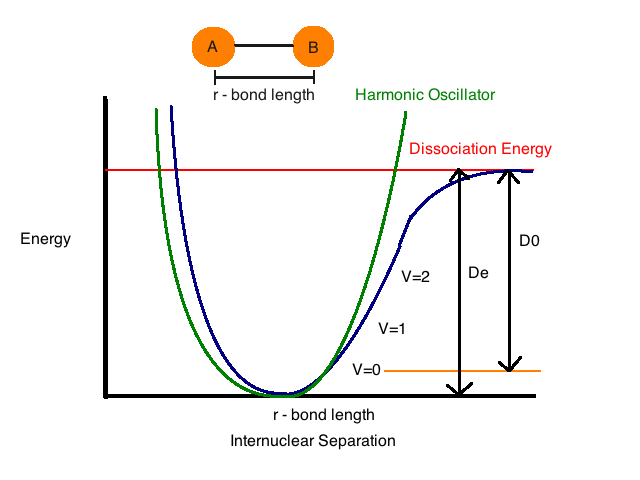Difference Between Bond Energy and Bond Dissociation Energy Enthalpy
Bond Energy Vs. Bond Dissociation Energy (Enthalpy)
Bond energy is the average value of the gas-phase bond dissociation energies (usually at a temperature of 298 K) existing between the same types of atoms. However, bond energy and bond dissociation energy are not the same. Bond dissociation energy is the standard enthalpy change when a covalent bond (also termed as a molecular bond, is a chemical bond between two non-metal atoms, that involves the sharing of electron pairs between those atoms) is cleaved by homolysis (breakdown to equal pieces) to give fragments; which are usually radical species. Hence, the major difference between bond energy and bond dissociation energy is that bond energy is an average value whereas bond dissociation energy is a particular value for a particular bond.
What is bond energy and bond dissociation energy (enthalpy)?
Bond Energy
Bond energy refers to the energy that is required to break down all the bonds that exist between the same 2 type of chemical species in a compound.
A plot of the potential energy of a 2-atom system and the distance between the chemical species shows the distance at which the energy is too less. This distance revealed is the bond length between the atoms.
The higher the bond energy (E) linked with a specific chemical species pair, the stronger the bond is said to be, and lesser the distance between the 2 atoms.
Bond Dissociation Energy
Bond dissociation energy (enthalpy) (H) is the amount of energy required for breaking down a particular bond in homolysis. We can define it as the enthalpy change that takes place when a bond undergoes cleavage by homolysis. Bond dissociation energy is specific to a single bond.
Bond enthalpy, (thermodynamic property of a system) or bond dissociation energy, is termed as the standard enthalpy change when a bond is cleaved (separated or divided) by homolyses (breaking down into small pieces) with reactants and products of the homolysis reaction at 0 K (absolute zero).
Difference between Bond Energy & Bond Dissociation Energy (Enthalpy)
Description
Bond energy
Bond energy is also termed as bond enthalpy and it is defined as the measure of bond strength in a chemical bond. Bond energy is an average value
Bond dissociation energy
Bond dissociation energy is defined as the standard enthalpy change which is required to break a chemical bond
Product
Bond energy
Bond energy offers the energy needed to form the atoms which are the starting material for bond formation.
Bond dissociation energy
Bond dissociation energy provided the energy needed to form free radicals from the atoms which created that particular bond.
Example
Bond energy
In chemistry, bond energy (E) or bond enthalpy (H) is the measure of bond strength in a chemical bond. … For example, the (C-H) carbon–hydrogen bond energy in methane (CH4) is the enthalpy change involved with breaking up one molecule of CH4 into a carbon (C) atom and four hydrogen (H) radicals, divided by four.
Bond dissociation energy
For example, in methane molecule, bond dissociation energies for C-H bonds are 439 kJ/mol, 460 kJ/mol, 423 kJ/mol and 339 kJ/mol. However, the bond energy of the C-H of methane is 414 kJ/mol, which is the average of all four values. Further, for a molecule, bond dissociation energy may not necessarily be equal to the bond energy (as for above-given methane example). For a diatomic molecule, bond energy and the bond dissociation energy are the same.
Symbol
Bond energy
It is denoted by E
Bond dissociation energy
It is denoted by H
Bond Formation
Bond energy
It gives the energy needed to form the atoms which were the starting material for bond formation
Bond dissociation energy
It gives the energy required to create free radicals from the atoms which created that particular bond
Summary of Bond Energy vs. Bond Dissociation Energy
The points of difference between Bond energy and Bond dissociation energy have been summarized as below:
- Difference Between Global Warming and Greenhouse Effect - May 18, 2024
- Difference Between Vaccination and Immunization - March 3, 2024
- Difference Between Selective Mutism and Autism - February 25, 2024
Search DifferenceBetween.net :
1 Comment
Leave a Response
References :
[0]Benson, S. W. (1965). III-Bond energies. Journal of Chemical Education, 42(9), 502.
[1]Blanksby, S. J., & Ellison, G. B. (2003). Bond dissociation energies of organic molecules. Accounts of chemical research, 36(4), 255-263.
[2]Darwent, B. D. (1970). Bond dissociation energies in simple molecules (No. NSRDS-NBS-31). National Standard Reference Data System.
[3]Szwarc, M. (1948). The C–H bond energy in toluene and xylenes. The Journal of Chemical Physics, 16(2), 128-136.
[4]Treptow, R. S. (1995). Bond Energies and Enthalpies: An Often-Neglected Difference. Journal of chemical education, 72(6), 497.
[5]Image credit: https://commons.wikimedia.org/wiki/File:Internuclear_separation_with_respect_to_bond_length.png
[6]Image credit: https://commons.wikimedia.org/wiki/File:Bond_Energy_Diagrams.png




Using chlorine as an example difficult between bond energy and bond disassociation energy